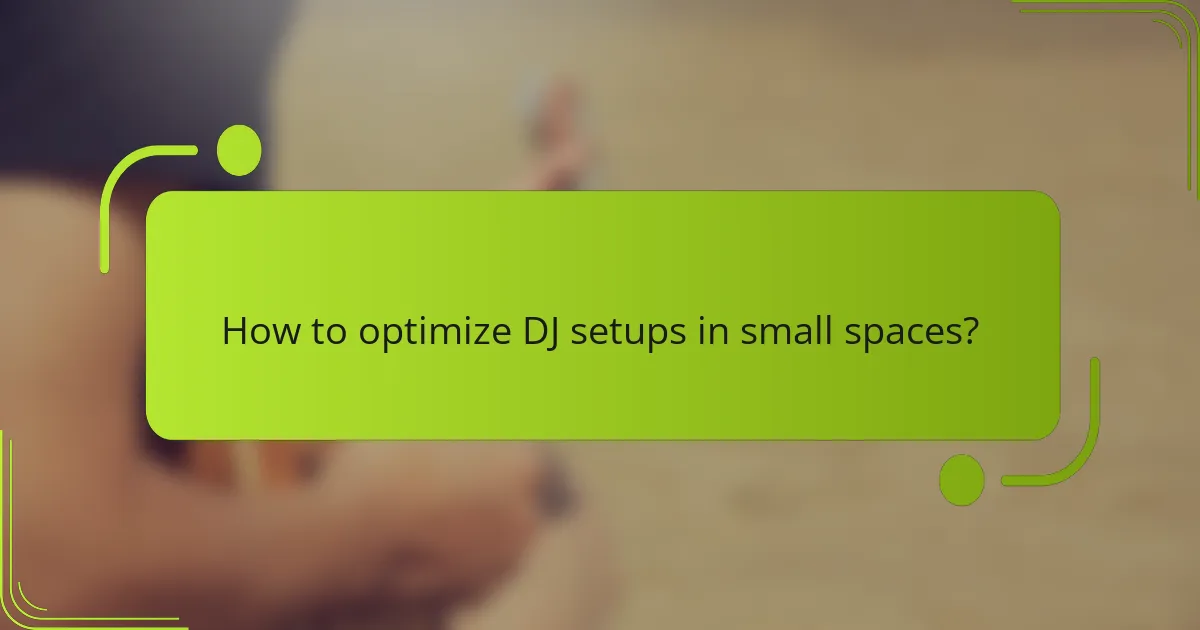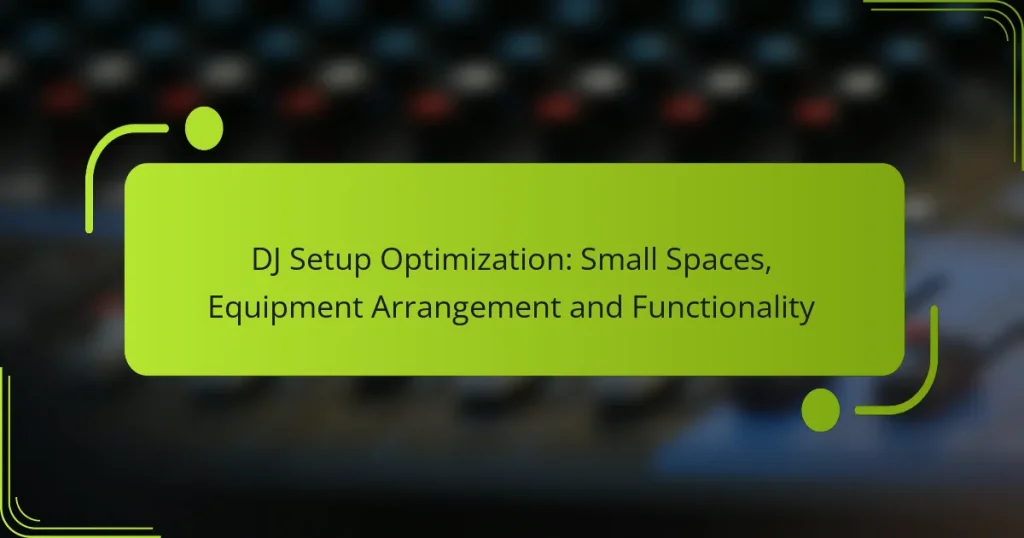Optimizing a DJ setup in small spaces requires careful consideration of compact equipment, efficient arrangement, and overall functionality. By prioritizing these elements, DJs can enhance their performance while making the most of limited space. A well-thought-out layout not only improves workflow and accessibility but also elevates sound quality, ensuring an impactful experience for both the DJ and the audience.

How to optimize DJ setups in small spaces?
To optimize DJ setups in small spaces, focus on compact equipment, efficient arrangement, and functionality. Prioritizing these elements will enhance your performance while maximizing the limited area available.
Utilize compact equipment
Choosing compact equipment is essential for small spaces. Look for smaller mixers, portable controllers, and lightweight speakers that still deliver quality sound. Brands often offer models specifically designed for tight areas, ensuring you don’t sacrifice performance for size.
Consider gear like all-in-one DJ systems that combine multiple functions into a single unit. This reduces the number of individual pieces you need, freeing up valuable space.
Vertical storage solutions
Implementing vertical storage can significantly increase your available space. Use wall-mounted shelves or racks to store equipment and accessories, keeping the floor area clear. This approach not only saves space but also makes it easier to access your gear.
Consider using pegboards or hooks for hanging headphones, cables, and other small items. This keeps everything organized and within reach while maintaining a tidy setup.
Multi-functional gear
Investing in multi-functional gear can streamline your setup. Look for equipment that serves more than one purpose, such as a speaker that doubles as a stand or a controller with built-in effects. This reduces the number of items you need to manage.
For example, a DJ controller with a built-in audio interface can eliminate the need for separate devices, saving both space and setup time.
Efficient cable management
Effective cable management is crucial in small spaces to prevent clutter and confusion. Use cable ties, clips, or sleeves to bundle and secure cables, keeping them organized and out of the way. This not only improves the appearance of your setup but also reduces the risk of tripping hazards.
Labeling cables can also help you quickly identify connections, making setup and breakdown more efficient.
Soundproofing techniques
Soundproofing is important in small spaces to minimize noise leakage and improve sound quality. Use acoustic panels or foam to absorb sound and reduce echo. These materials can be installed on walls or ceilings without taking up much space.
Additionally, consider using rugs or carpets to dampen sound reflections from hard surfaces. This can enhance the overall audio experience for both the DJ and the audience.

What equipment arrangements enhance functionality?
Effective equipment arrangements can significantly improve the functionality of a DJ setup, especially in small spaces. Prioritizing a logical layout allows for better workflow, ease of access, and enhanced sound quality.
Triangle setup for mixers and decks
A triangle setup involves positioning the mixer and decks in a triangular formation, which promotes efficient use of space and easy access to all components. Place the mixer at the apex of the triangle, with the decks on either side, ensuring that all controls are within reach.
This arrangement allows for quick transitions between tracks and seamless control over effects and volume. When space is limited, consider using compact gear that fits well within this triangular layout without overcrowding.
Placement of speakers for optimal sound
To achieve optimal sound quality, speakers should be placed at ear level and angled towards the audience. This positioning ensures that sound waves reach listeners directly, minimizing distortion and maximizing clarity.
In small spaces, avoid placing speakers too close to walls, as this can cause unwanted reflections and muddiness. Instead, aim for a distance of at least one meter from walls, if possible, to enhance sound projection and reduce feedback.
Accessibility of controls
Ensuring that all controls are easily accessible is crucial for a smooth DJ performance. Position frequently used equipment, such as effects units and laptops, within arm’s reach to minimize disruptions during a set.
Consider using stands or racks that can elevate gear to a comfortable height, reducing strain and improving workflow. Regularly assess your setup to identify any equipment that may require repositioning for better accessibility.
Lighting integration
Effective lighting integration can enhance the overall atmosphere of a DJ performance. Position lights to highlight the DJ booth and dance area, creating an engaging experience for the audience.
In small spaces, opt for compact LED fixtures that can be easily mounted or placed on stands. Ensure that lighting controls are also within reach, allowing for quick adjustments to match the energy of the music without interrupting the flow of the set.

Which digital products assist with setup optimization?
Several digital products can significantly enhance setup optimization for DJs, especially in small spaces. These tools help streamline equipment arrangement, improve functionality, and maximize the use of available space.
DJ software for layout planning
DJ software designed for layout planning allows users to visualize their setup before physically arranging equipment. Programs like DJ TechTools’ DJ Setup Planner or similar applications enable DJs to create a virtual representation of their gear, helping to identify the best placement for mixers, turntables, and speakers.
When selecting layout planning software, consider features such as drag-and-drop functionality and the ability to save multiple configurations. This can help you experiment with different setups to find the most efficient arrangement for your specific space.
Virtual reality tools for spatial arrangement
Virtual reality (VR) tools provide an immersive way to plan your DJ setup in small spaces. Applications like Spatial or similar VR platforms allow DJs to simulate their environment, making it easier to visualize how equipment will fit and interact within the physical space.
Using VR for spatial arrangement can help identify potential issues, such as sound reflections or accessibility problems, before setting up. Ensure your VR tool is compatible with your equipment and offers realistic scaling to accurately represent your setup.
Online communities for tips and tricks
Online communities, such as forums and social media groups, are valuable resources for DJs seeking setup optimization advice. Platforms like Reddit, DJ TechTools, and Facebook groups offer a wealth of shared experiences, tips, and tricks from fellow DJs who have navigated similar challenges.
Engaging with these communities can provide insights into effective equipment arrangements and common pitfalls to avoid. Consider participating in discussions or asking for feedback on your planned setup to gain diverse perspectives and practical suggestions.

What are the best practices for DJing in confined areas?
To optimize DJing in confined spaces, focus on efficient equipment arrangement, sound management, and adaptability to the venue’s characteristics. These practices ensure functionality and enhance the overall experience for both the DJ and the audience.
Regular equipment maintenance
Maintaining your DJ equipment is crucial for performance in small venues. Regularly check cables, connectors, and devices for wear and tear to prevent malfunctions during events. Schedule routine cleanings and inspections to keep everything in optimal condition.
Consider investing in a quality maintenance toolkit that includes cleaning supplies, spare cables, and basic repair tools. This preparation can save you time and stress, especially in tight spaces where quick fixes are essential.
Testing sound levels before events
Testing sound levels prior to an event is vital in confined areas to avoid overwhelming the space with excessive volume. Use a sound meter to measure decibel levels, aiming for a balanced mix that accommodates the venue’s acoustics without distortion.
Conduct sound checks at various points in the venue to identify any dead spots or areas with feedback issues. Adjust your equipment settings accordingly to ensure a consistent audio experience for the audience throughout the space.
Adapting to venue acoustics
Understanding and adapting to the acoustics of a venue is essential for effective DJing in small spaces. Different materials and layouts can significantly affect sound quality, so take note of reflective surfaces and potential sound dampeners.
Experiment with speaker placement and equalization settings to achieve the best sound. In some cases, using acoustic panels or portable sound absorbers can help manage echo and improve clarity, enhancing the listening experience for everyone present.

How to choose the right gear for small spaces?
Selecting the right gear for small spaces involves prioritizing portability, functionality, and sound quality. Compact equipment allows for efficient use of limited space while still delivering a powerful performance.
Research portable DJ controllers
Portable DJ controllers are essential for maximizing functionality in confined areas. Look for models that are lightweight and have a built-in sound card, which eliminates the need for additional equipment. Popular brands often offer controllers that fit easily into a backpack, making transport simple.
When choosing a controller, consider features like the number of channels, compatibility with software, and the layout of controls. A controller with a smaller footprint but robust features can be ideal for small venues or home setups.
Consider lightweight speakers
Lightweight speakers are crucial for maintaining sound quality without taking up too much space. Look for options that offer a good balance between portability and audio performance, such as active speakers that integrate amplifiers within the unit.
Models weighing around 10-15 kg are often manageable for transport and setup. Additionally, consider speakers with built-in Bluetooth capabilities for wireless connectivity, reducing cable clutter in tight spaces.
Evaluate all-in-one systems
All-in-one DJ systems can be a practical solution for small spaces, combining multiple functions into a single unit. These systems typically include a mixer, speakers, and sometimes even lighting, which simplifies setup and reduces the need for extra gear.
When evaluating these systems, check for sound quality, ease of use, and the range of features included. While they may have limitations in terms of customization, they can be a great choice for mobile DJs or those with limited space.


